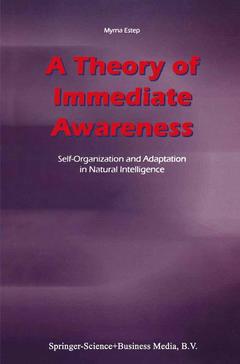A Theory of Immediate Awareness, Softcover reprint of hardcover 1st ed. 2003 Self-Organization and Adaptation in Natural Intelligence
Langue : Anglais

This book is multi- and interdisciplinary in both scope and content. It draws upon philosophy, the neurosciences, psychology, computer science, and engineering in efforts to resolve fundamental issues about the nature of immediate awareness. Approximately the first half of the book is addressed to historical approaches to the question whether or not there is such a thing as immediate awareness, and if so, what it might be. This involves reviewing arguments that one way or another have been offered as answers to the question or ways of avoiding it. It also includes detailed discussions of some complex questions about the part immediate awareness plays in our over-all natural intelligence. The second half of the book addresses intricate and complex issues involved in the computability of immediate awareness as it is found in simple, ordinary things human beings know how to do, as weIl as in some highly extraordinary things some know how to do. Over the past 2,500 years, human culture has discovered, created, and built very powerful tools for recognizing, classifying, and utilizing patterns found in the natural world. The most powerful of those tools is mathematics, the language of nature. The natural phenomenon of human knowing, of natural intelligence generally, is a very richly textured set of patterns that are highly complex, dynamic, self-organizing, and adaptive.
1. The Problem of Immediate Awareness.- 2. The Primitive Relations of Knowledge by Acquaintance.- 3. Arguments Against Immediate Awareness: The Case of Naturalism.- 4. What does the Evidence Show?.- 5. Boundary Set S: At the Core of Multiple Intelligences.- 6. Can Neural Networks Simulate Boundary Set S?.- 7. Computability of Boundary Set S.- 8. Summary and Conclusions.- References.
Date de parution : 12-2010
Ouvrage de 316 p.
15.5x23.5 cm
Date de parution : 05-2003
Ouvrage de 316 p.
15.5x23.5 cm
Thème d’A Theory of Immediate Awareness :
© 2024 LAVOISIER S.A.S.
